The Clematis genus contains about 300 species of flowering bushy and climbing perennials that are suited to cultivation in USDA Hardiness Zones 4 to 9.
They prefer organically rich, well-drained soil and full sun to part shade locations. Bloom times vary by species.

We link to vendors to help you find relevant products. If you buy from one of our links, we may earn a commission.
Ordinarily, clematis foliage is green and lush, but a plant signals distress when the leaves turn yellow.
In our guide to growing clematis, we discuss all you need to know to grow these plants at home.
This article suggests nine reasons why foliage may turn yellow to guide you in taking appropriate actions in your garden.
Here’s what we’ll cover:
Reasons for Clematis Leaf Yellowing
Let’s jump in and get this problem solved!
1. Animal Urine
If the lower leaves are starting to shade to yellow, there may be a simple reason – animal urine.
Does the vine climb a lamppost by your front walk? Drape over a roadside mailbox?
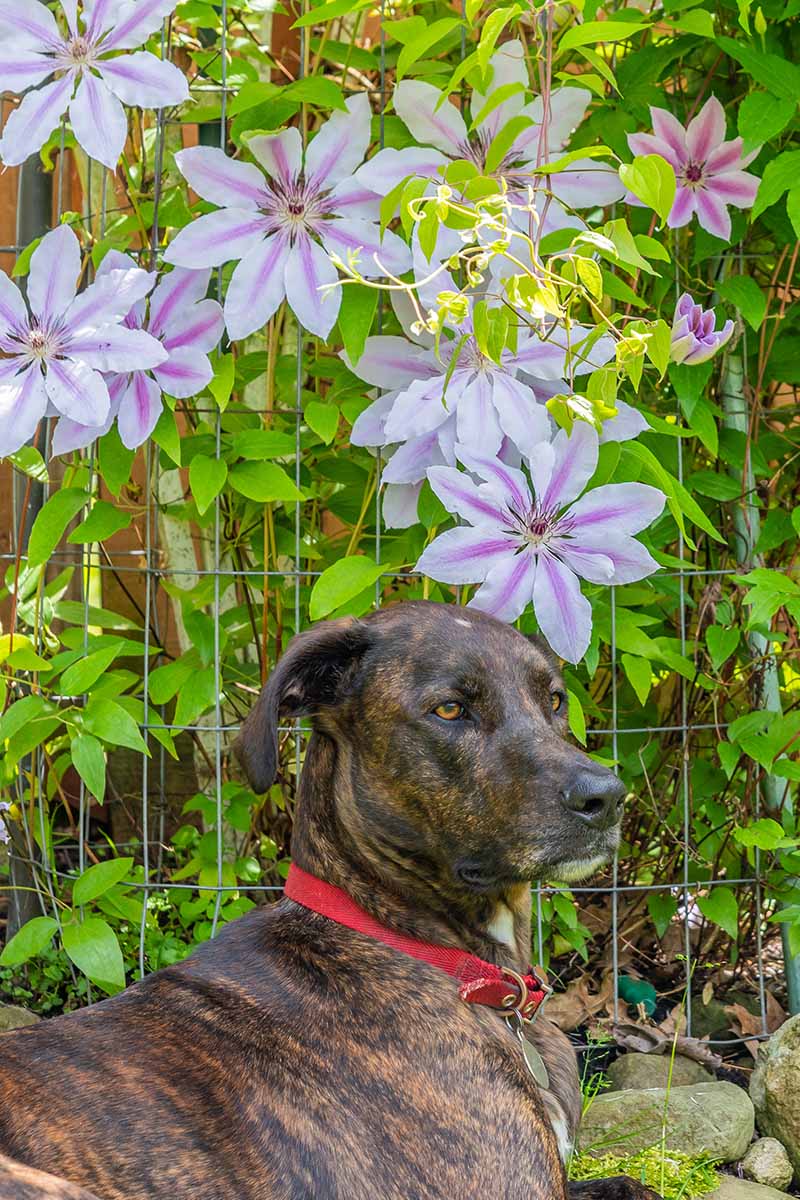
If so, the problem may be of a rather – ahem – intimate nature.
Your lovely flower may have become a favorite pitstop for neighborhood animals like dogs and foxes.
Yes, folks, while dog walkers may diligently scoop their pups’ poop, urine is another story. Rich in nitrogen and salts, it’s like an overdose of fertilizer and can dehydrate and burn plant tissue.
There are dog deterrent products on the market, but please think carefully before using one. The goal is not to punish with harsh smells and tastes but to deter.
Instead, we recommend creating a plant barrier with bricks, fencing, or rocks.
Alternatively, you can grow clematis in a container beside the lamppost or mailbox to bring its lower stems and foliage up higher and out of reach.
2. Aphids
Clematis may serve as host to numerous aphid species, including Aphis clematidis, A. vitalbae, Colophina clematis, and Myzus varians.
They are tiny, soft-bodied pests in colors ranging from green to black that become very visible when they stack on top of one another on stems, foliage, buds, and blossoms.
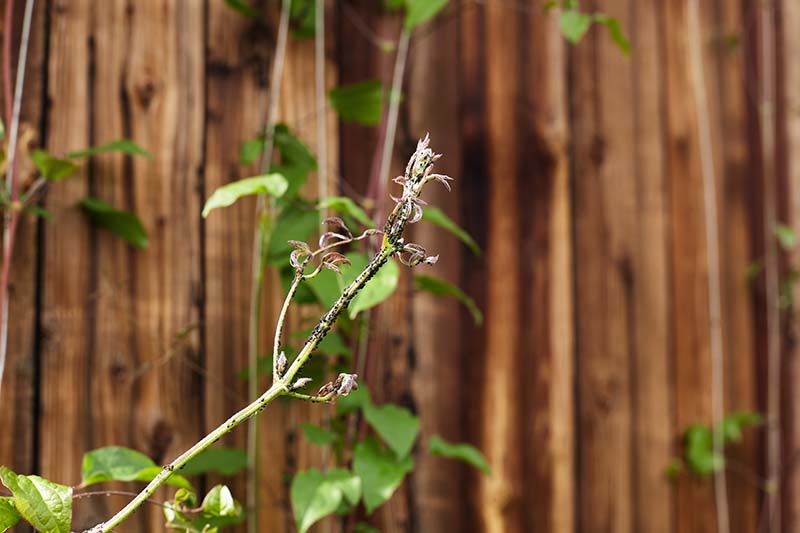
Aphids are sap-sucking insects that feed on the juices of plant tissue, excreting sticky trails of “honeydew” as they go. Unchecked, their activity can cause leaves to become light green to yellow as they become dry and unable to absorb sunlight.
When you spot the first few bugs on the yellowish leaves, try to dislodge the bugs with a firm spray from the hose nozzle.
If this isn’t adequate, apply organic insecticidal neem oil. Repeat treatments may be necessary.
Prune off and discard severely damaged flora in the trash by cutting stems just above a leaf node.
You can learn more about how to manage aphids in our guide.
3. Clematis Slime Flux
Also known as bacterial wetwood, this condition originates in plant stems, causing them to fill with an oozy slime and turn adjacent foliage yellow.
It is likely caused by species of bacteria from several genera, including Enterobacter, Klebsiella, and Pseudomonas.
Plants that are damaged are the most vulnerable. Use mowers and weed whackers with caution, don’t plant in windy locations, and apply mulch over the root zone to insulate against winter freezing.
The visible damage from these bacteria looks dire, but often the swift removal of affected stems is all that is needed to stimulate healthy new growth.
4. Excess Moisture
Yellow leaves may indicate oversaturation, either by overzealous watering or Mother Nature’s rainfall. If a clematis gets more than one inch of water per week, it may be too much for the roots to handle.

We can’t control the weather, but choosing a sunny location with well-drained soil and avoiding overcrowding go a long way to helping wet soil dry out.
If you have a plant that always seems to be wet, cut it to the ground at season’s end, dig it up, and relocate it. You may even want to divide it before replanting.
5. Nutrient Imbalance
If you notice that the older leaves at the bottoms of the stems are looking a little peaked, the soil nutrients may be out of balance.
Typical causes are deficiencies in nitrogen and magnesium that can occur when another element is too prevalent in the soil and inhibits the roots from taking up these essential nutrients.
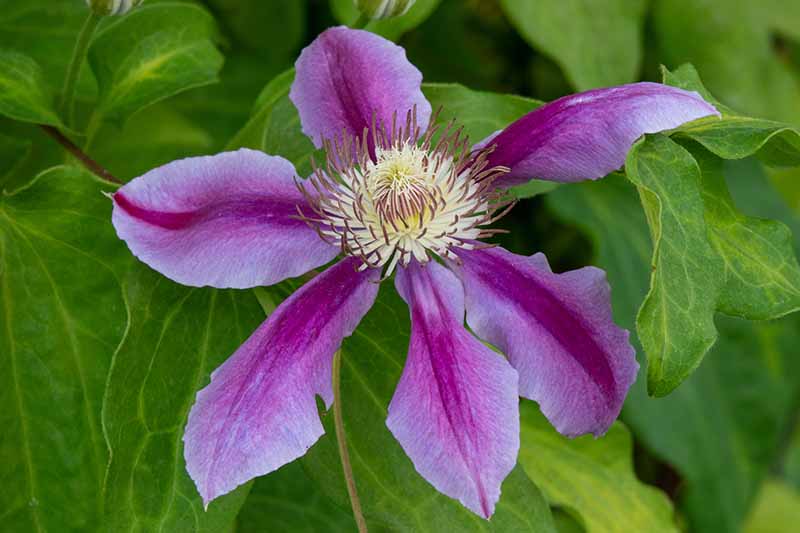
One element that may be too abundant is potassium, the “K” part of the phosphorus, nitrogen, and potassium, or N-P-K, fertilizer mix.
The only way to know if soil nutrients are available as needed is to do a soil test. In the meantime, avoid fertilizers that are not well-balanced, particularly those that are heavy with potassium.
Once you have the soil test results, you can amend the soil as recommended.
If you opt to skip the soil test, you may want to apply a well-balanced tomato or rose fertilizer per package instructions.
Some folks swear by adding diluted Epsom salts to garden soil to boost its magnesium content, but as the pros at the University of Minnesota Extension recommend, this practice is ill-advised without a soil test.
6. Powdery Mildew
Fungi in the Erysiphe genus wreak havoc on many garden plants in the form of powdery mildew infection.
Symptoms include a fuzzy whitish-gray coating on foliage that turns yellow and then brown as the leaves die. The fungi may also produce tiny yellow “fruiting bodies.”
Unlike other fungal conditions, powdery mildew does not need water for spore activation. Ambient humidity, overcrowding, and shade are enough to get it going.
And, the activity of aphids can contribute to the spread of spores.
For treatment details, consult our article on powdery mildew.
Plants that are well spaced and in sunny locations are less likely to suffer from this ailment.
7. Rust
Clematis that falls victim to rust may exhibit leaf yellowing due to colonization by yellow/orange fungal spores from fungi in the Aecidium and Puccinia genera, as well as Coleosporium clematidis.
Plants become susceptible when their foliage remains wet for extended periods, and there is poor air circulation around the stems and between plants.
Without a wet place to germinate, the spores of these fungi are not likely to be a problem. We can’t control the rain, but when watering, we can be sure to aim the hose nozzle at the soil and not over the leaves.
The removal of affected foliage and an application of organic fungicidal (and insecticidal) neem oil are appropriate treatments for rust.
8. Tomato Black Ring Virus
Tomato ringspot virus (ToRSV) is caused by a soilborne pathogen that may be present in a plant when you buy it. It’s an incurable type of “nepovirus” transmitted by parasitic nematodes in the soil.
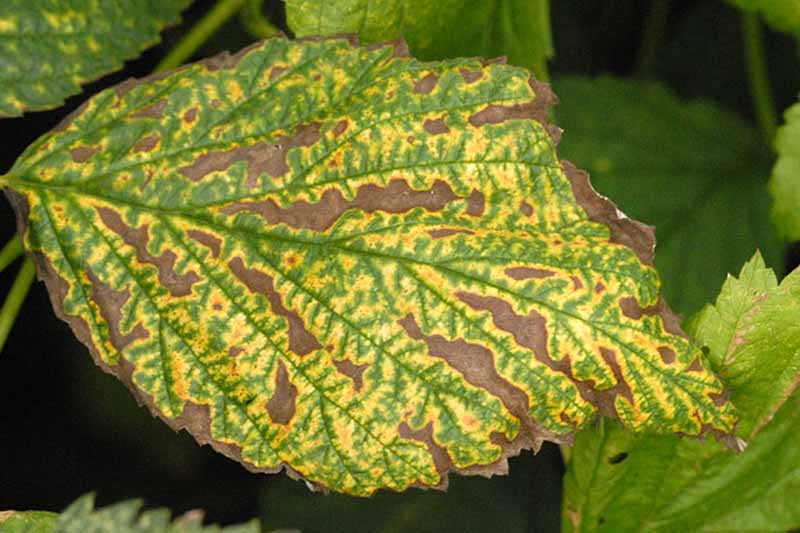
Primary hosts of this fatal infection are the tomato and strawberry, so be aware of planting in proximity.
Symptoms include streaks or patches of yellow on the foliage, deformity, and stunted growth.
This disease is incurable. The only recourse is to remove affected plants and discard them in the trash.
9. Whiteflies
Sapsucking whiteflies, members of the Aleyrodidae family, belong to the Hemiptera order. In other words, these are “true bugs,” and not really flies at all.
These pests infest flora, stunting growth and turning the leaves yellow, then brown, before withering and dropping.
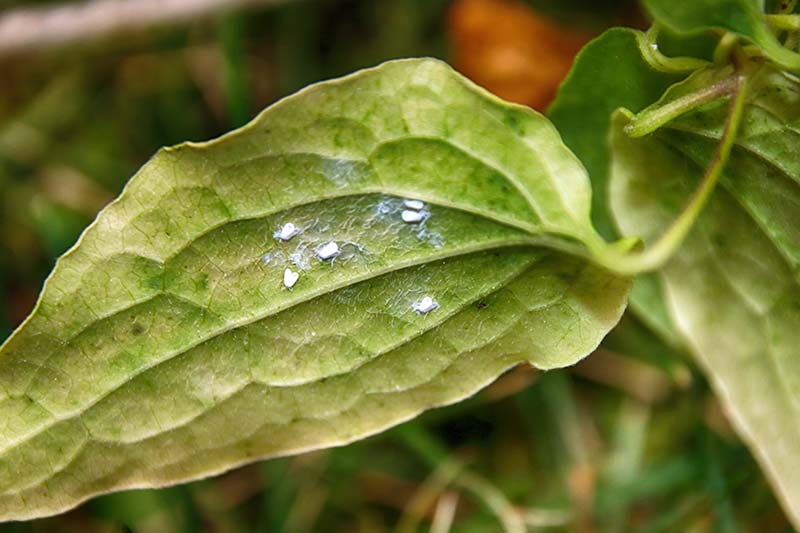
To confirm an infestation, turn a leaf over and watch for a puff of white as the adults take flight.
Unfortunately, this condition can be hard to eradicate as the pests have become quite resistant to commercial treatments.
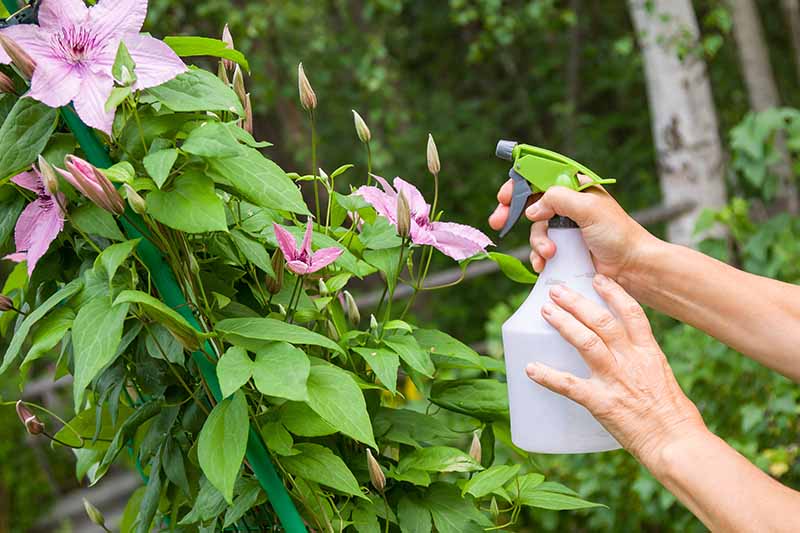
A foliar application of insecticidal (and fungicidal) neem oil is often successful.
Heed the Warning
With these nine reasons for yellow foliage, you’re ready to assess the condition of your clematis.
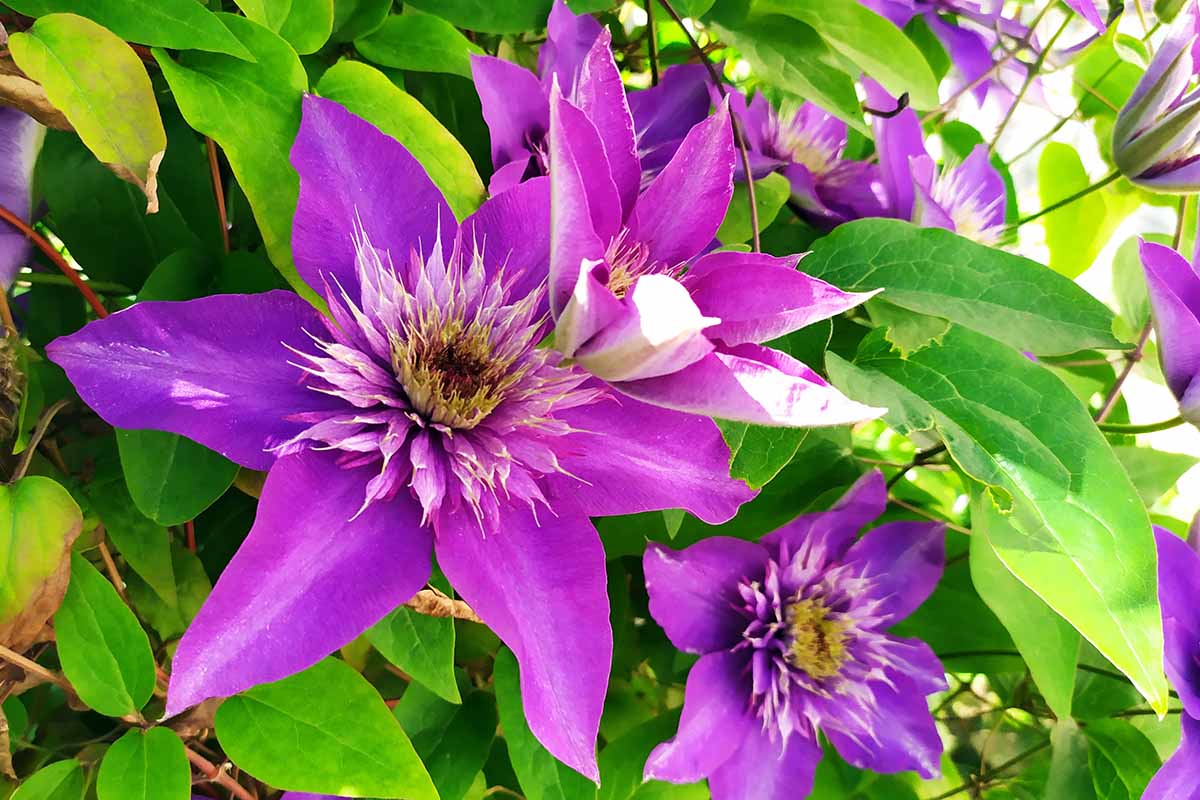
With best garden practices, like selecting high-quality specimens and providing plenty of sunshine, good drainage, balanced fertilizer, and moderate watering, you are well on your way to having healthy plants.
Walk through the garden regularly and check plants for leaf discoloration. Look for signs of pests, like aphids and whiteflies, as well as diseases, like powdery mildew, rust, slime flux, and tomato black ring virus.
Consider your watering habits and whether or not animals may be visiting your property.
If you find that yellow leaves persist despite addressing the above issues, contact the agricultural extension of a local university or a clematis society chapter in your area to aid you in evaluating the health of your plants.
Do you grow clematis? Please share your experience in the comments section below.
If you found this article about clematis cultivation useful, we recommend reading the following next: